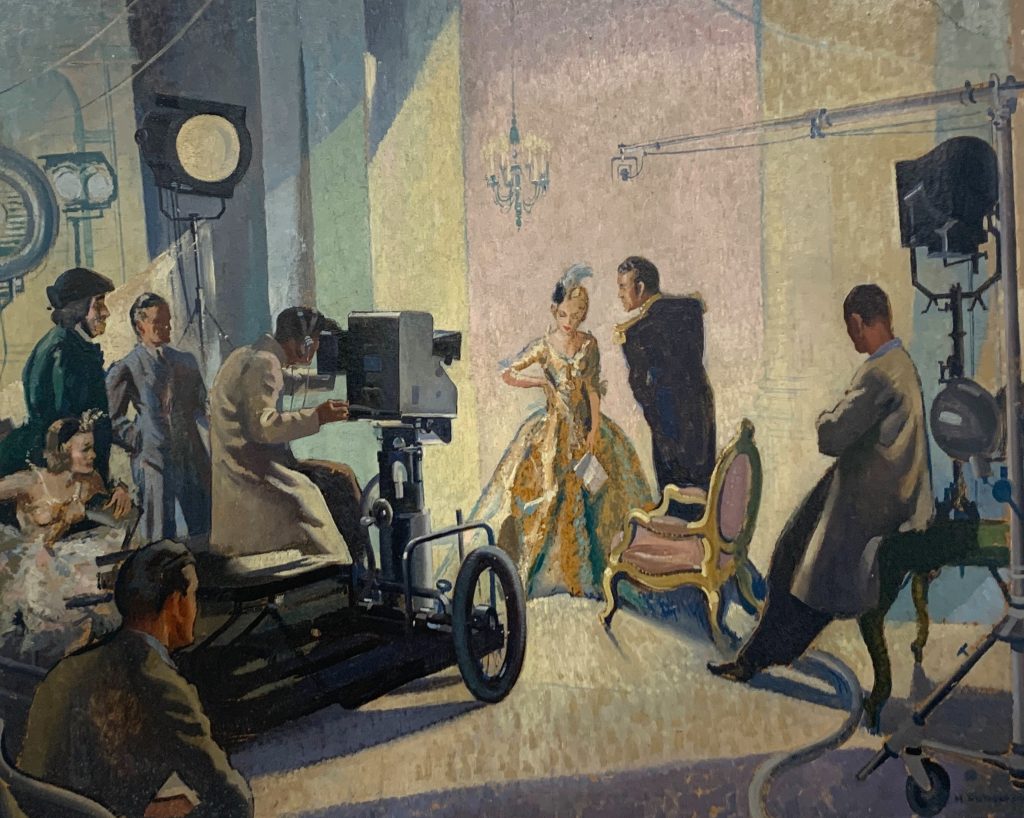OTD in early British television: 7 December 1937

John Wyver writes: On this day, Tuesday 7 December 1937, Harry Rutherford squeezed himself into a corner of the crowded Studio A at Alexandra Palace, or so I believe, and made preliminary sketches for his painting ‘Starlight’, the most vivid and alluring image of pre-war television (above).
The contrast between the brightly illuminated elegance of the costumed couple, and the dark mysteries of the dolly-mounted Emitron, the delicate fishing-rod mic, and the looming lamps, is perfectly judged. The finished painting currently graces the reading room of the BBC Written Archives Centre at Caversham, although I fear it fails to receive the attention that it deserves from researchers focussed on their scholarly missions.
Harry Rutherford (1903-1985) was a Manchester-born artist who trained under Walter Sickert, and who the older artist described as ‘my intellectual heir and successor’. A well-regarded realist painter, he was also the figure who BBC producer Cecil Madden turned to when he wanted to create for an Alexandra Palace series a format that owed nothing to the stage or cinema.
The result was Cabaret Cartoons, first seen in fact on 7 December 1936 (although that’s not the anniversary I’m mostly celebrating today). This featured Rutherford doing what Madden recalled in his memoir as ‘a progressive drawing of the artist performing on the studio floor – the viewers could see both working in superimposition and they finished together.’
The first show in December 1936 showcased Rutherford sketching foot juggler Levanda, Janet Lind with ‘songs and taps’, rope spinning act The Shamvas, silent comic Chaz Chase (performing to Gershwin’s ‘I’ve Got Rhythm’) and acrobatic dancers Leona and de Leon. They truly don’t put together variety bills like that anymore.
Cabaret Cartoons was a staple of the schedule from 1936 onwards, as was Starlight, another Madden conception as a catch-all title for short presentations of singers, instrumentalists and comics. ‘Starlight’ is what Rutherford called his painting, but why do I believe that he began it a year after the first Cabaret Cartoons, on 7 December 1937? Because I’m convinced it depicts the live broadcast that night of the edition of Starlight that featured Steve Geray (1904-1973) and Magda Kun (1912-1945).
Born in what is now Ukraine, Geray was educated in Budapest and acted at the Royal Hugarian Theatre . He made his London stage debut in Happy Weekend in 1934, which was also the year that he and Magda Kun were married. She too acted in comedies and revues in Budapest, before performing with Geray in Happy Weekend. Both were popular variety artists as well, and Geray later claimed that, because of his impersonations of Hitler and Mussolini when he was performing in Paris, the German and Italian governments had arranged for him to be beaten up.
Steve Geray and Magda Kun made their television debut in March 1937 when producer Dallas Bower had them perform a sketch titled ‘Insane’ for the Starlight strand. Relatively few editions of Starlight featured a pair of performers, which is one indication towards believing that the painting might depict the edition on 7 December.
That night producer J. Royston Morley had them give the musical sketch ‘My wireless installation can pick up every station’, which is perhaps not an obvious subject for a ballgown bedecked lady and a gentleman in formal dress. However, the PasB (thanks again to Andrew Martin’s invaluable Sound & Vision volumes, in this case no. 3) details that the song came from Egy Csok es mes Commi.
A little rabbit-hole burrowing online, and the help of an automated Hungarian to English translation system, suggests that the PasB has got the title slightly wrong, and that in fact this refers to the Hungarian operetta Egy csók és más semmi by Eisemann Mihály. First performed in Budapest in the May 1932, and thus familiar to Geray and Kun, who might even have appeared in it, this was made into a film by Ákos Ráthonyi with the translated title of A Kiss and Nothing Else.
The operetta is a contemporary tale of divorce and love, and this extract from the film could well be the scene that Steve Geray and Kagda Kun are performing in ‘Starlight’. Anyway, that’s as good a tale about Rutherford’s delightful painting as I can come up with.
Steve Geray and Magda Kun separated when Geray moved to Hollywood in 1941. After making a success of the lead role in Joseph H. Lewis’s low-budget So Dark the Night (1946) he had a solid career working with A-list directors including Alfred Hitchcock, Joseph Mankiewicz and Howard Hawks, and specialising in crime films including Gilda (1946).
After working in England during the war for the United States Office of War Information, Magda Kun died aged 33 in the French Hospital in London soon after filming a small role in the 1945 Ealing drama Dead of Night.
Header image: Harry Rutherford, ‘Starlight’, 1937; author’s photograph; artwork used under the ‘for the purposes of criticism or review’ provisions of CDPA, 1988.
Leave a Reply